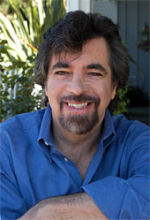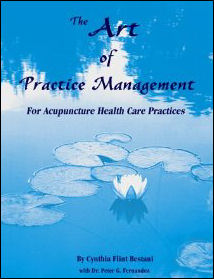Acupuncture & TCM Articles

Neil R. Gumenick is the founder and Director of The Institute of Classical Five-Element Acupuncture. Neil is a Worsley certified advanced teacher of Classical Five-Element Acupuncture and a practitioner with over 27 years of private practice experience. Neil holds three degrees from the College of Traditional Acupuncture (U.K.), and he participated for 10 years in the Master Apprentice Programô, led by Profs. J.R. & J.B. Worsley. Neil has taught at the USC and UCLA Schools of Medicine, the Worsley Institute of Classical Acupuncture, the Traditional Acupuncture Foundation, California Acupuncture College, Santa Barbara College of Oriental Medicine, and Pacific College of Oriental Medicine. He has been a Professor at Emperor's College of Traditional Oriental Medicine and SAMRA University of Oriental Medicine. Neil is co-author of The Art of Practice Management for Acupuncture Health Care Practices
The Initial Consultation: Getting to the Heart of the Matter, Part 5
By Neil Gumenick, MAc (UK), LAc, Dipl. Ac
In previous articles in this series, I discussed the diagnostic advantages of observing the patient before they are aware of being seen, the arrangement of the treatment room, and the wealth of information that is available from seemingly routine questions. I stressed the point that the verbal answers to these questions are of far less importance than the way in which the answers are given. Verbal information, i.e., the data or story, is at best the stuff of the mind. The vast majority of patients we see are imbalanced at the level of spirit; whom we believe ourselves to be at our deepest core identity. Though there may be physical symptoms present, a patient's ability to heal is vastly improved if we address the whole person, including the level of spirit.
Spirit is what makes us the unique beings we are, unlike anyone who ever lived or ever will live. Spirit is the spark of Divinity within - the perfect, radiant and eternal part of us. Spirit is what connects us to all, enabling us to feel love and compassion.

When we are imbalanced at the spirit level, our perception of our spirit is compromised. We become attached to our limited ego and its selfish and transitory desires, fears, manipulations, justifications and feelings of unworthiness or inferiority. All these things block clarity and peace, love and compassion. Classical Five-Element Acupuncture can help the patient overcome attachment to the transitory and its attendant suffering, and reconnect with the truest and deepest self.
Asking the Right questions
My teacher, Professor JR Worsley, recommended asking patients about their primary complaint with statements like, "Tell me your main trouble, how long you have had it, and what you have done for it." This is an open-ended invitation for patients to talk and freely express themselves for as long as they wish. They will often reveal who they are in relation to their symptom(s). As clinicians, we must remember that if we are truly treating holistically, we are not merely treating symptoms, but also supporting the unique individual who has the symptoms.
Using such open-ended questions, I allow the patient's answer to trigger my curiosity to ask a follow-up question. If a patient describes the main problem simply as right shoulder pain of one month's duration, I am likely to ask questions such as, "How did this start? What happened?" Then I may ask deeper questions, like, "How do you feel living with this pain? What does it keep you from doing? How does the condition affect you?" The answers to these kinds of questions will tell me, more than what the condition is, who the patient is. To perceive this, I listen to the sound of the voice and the predominant emotions during all of the interaction. (The diagnostic indicators of odor and color may be sensed before even the first word is spoken.)
Thus, the answers regarding the main complaint may be quite varied, but are always diagnostically useful. Questions such as, "Where is your pain?" though important to acknowledge and understand in strategizing treatment, are limiting in that they do not tell us about the patient's experience. One patient may be angry, frustrated or hopeless at their condition. Another may be sad and depressed, or inappropriately laughing the whole thing off. These are but a few examples of the myriad ways that the Officials will inform us, as practitioners, of their deeper needs. Our job is to perceive these needs directly and respond to them with out exact choice of points.
I ask the patient if they have any additional complaints. Many people do not know what classical acupuncture is capable of helping, beyond their hope of it helping the main complaint. Many certainly do not know that our medicine can and does help with issues in the nonphysical realms. I often tell patients that acupuncture is body/mind/spirit medicine and that unless all three levels are healthy and balanced, one cannot be truly healthy. Thus, problems at any level are appropriate for the patient to express. Many patients are surprised to hear this, as well as relieved. The door is then open for the patient to tell me, in their own words, anything they would like me to know. For some patients, what was considered to be secondary turns out to be far more serious and in need of attention than the symptom(s) that got them to my door.
Patients tend to forget or write off problems to which they have become accustomed, or deem them insignificant. In fact, nothing that troubles a patient is irrelevant. It may well happen that after several treatments, what was the primary physical problem has improved or is no longer the main focal point. I often find that at this juncture, the patient's attention shifts to the deeper imbalances of emotion, mind, and spirit.
By asking open-ended questions, rather than those to which a one-word answer would suffice, the patient is free to go in any direction with their report of secondary complaints. It is important for us to note this direction. What does the patient consider to be the priorities? With what sound and emotions are these issues expressed? Is the expressed emotion appropriate? What stands out as excessive or deficient? In this way, we hear the elements and Officials speaking to us. This is the core of our diagnostic art.
As Worsley taught, we cannot actually diagnose another person per se. Whatever we feel is in ourselves, in the patient's presence. From our own body, mind and spirit, we can perceive the elemental causative factor, as well as the patient's mental and spiritual needs. This information is then figured into the treatment plan.
Case Study
A 37-year-old woman came to me for treatment of insomnia. Starting with her first semester at college, she would lie in bed for hours with her mind racing. What little sleep she managed to get was short and fitful. The later it got, the more anxious she became. She said that she had been anxious her whole life. While living at home, her mother would worry about her incessantly, constantly hovering, over-protecting, and ultimately rescuing. In leaving home for college, the patient took with her all of her mother's anxieties. Except for short visits, the patient had never returned home, and the insomnia never ceased.
In questioning her about secondary complaints, which included low back pain, the same anxiety persisted. She could never be reassured enough. Did I ever help anyone with the same condition? How many treatments did it take? How sure was I that acupuncture would help? The sound of her voice was groaning. Her predominant emotion was fear. Her facial color was blue (lateral to the eyes), her odor putrid. In Classical Five-Element Acupuncture, these four pillars of diagnosis all pointed to the Water element as her causative factor.
The Water element provides a reserve of energy and power upon which to draw and sustain our lives. It cleanses and washes away impurities. It allows for flexibility and movement of the body, mind and spirit. It provides us with willpower, courage, and strength to carry on even through the most difficult of times. This patient's water had been so depleted through ceaseless worry and anxiety that she was utterly exhausted. As the exhaustion increased, so did the accompanying anxiety in a vicious circle. She lacked the ability to cleanse her own mind of its toxic and unrealistic fears and was internally paralyzed.
At her first treatment, the patient's pulses revealed an exit/entry block between the Small Intestine and Urinary Bladder meridians. (For a detailed explanation, please refer to Entry and Exit Points and Blocks) The presence of any energetic block will prevent any treatment from being effective. Clearing this block, as evidenced by the pulse change, made it possible for the patient to receive the benefit of the treatment(s) that followed.
Among the points I used over the next several treatments were: (Note that these were chosen to meet the need of this unique individual.)
Bladder 54: Equilibrium Middle (in some texts, this point corresponds to UB 40). The Bladder Official must be able to expand and contract, adjusting appropriately to the amount of water it contains, in order to keep the water in balance. Too much or too little, are extremes of imbalance. Water must be contained and controlled, as well as allowed to permeate to every corner of the body, mind and spirit. This patient was stuck in a pattern of drowning in her own wild and fearful imaginings. This point was chosen to bring her to her own internal center: to bring her mind and spirit together in a place of peace and stillness to her turbulent water. As the earth point of the meridian, it brings control to water, as well as the maternal qualities of stability, security, nurturing, and grounding.
Kidney 10: Yin Valley. This point name reminds us of a quiet, peaceful, and tranquil valley. It is cool, shady, and calming. The overactive, uncontrolled waters of this patient's mind could be gathered, cleansed and gently revitalized. It strengthens the water in itself, filling, clarifying and neutralizing the turbulence of fear, and allowing harmony, rest and recharge.
On the patient's second visit (one week after the first), she reported that she slept eight uninterrupted hours the night of the first treatment. She reported no trouble falling or staying asleep. Subsequent nights varied from seven to eight hours, with the occasional short awakening. By the fourth treatment, she reported consistent sleep, awakening feeling rested without anxiety or back pain, She stated that she felt like a different person, then corrected herself, "No, I feel like me for the first time."
 
The Art of Practice Management for Acupuncture Health Care Practices
What you will find in this book is a specific, comprehensive approach that gets to the root cause of success in practice.
This new book presents acupuncture practice as art from the standpoint of centering, qi, and wholeness. It builds on the premise that practices succeed from bridging inner and outer aspects of the self. It is an inquiry into the self and addresses clear understandings and approaches to reputable patient care and practice qi. It brings in the five elements and work with the seasons of practice from training and start-up to growth, stability, expansion and transformation. The authors artfully bridges the essence of both patient and practitioner well-being without excluding the practicalities of financial well-being. This book very specifically and extensively shows how the different parts of practice nourish and feed one another and are interdependent on one another for the qi to flow synchronistically.
It explores the dual nature of procedures that work and those which do not in acupuncture health care practice, returning again and again to the delicate balance of practicality and spirituality.
|
